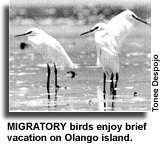| TravelSmart.NET
Archive Home |
|
| Inquirer.NET
Home |
|
| TravelSmart.NET
Home |
|

 THE SMALL bird was caught easily by the mesh net as it swooped down to
catch a marine worm found in abundance on the tidal flats of Olango Island,
about 10 kilometers from Cebu City.
THE SMALL bird was caught easily by the mesh net as it swooped down to
catch a marine worm found in abundance on the tidal flats of Olango Island,
about 10 kilometers from Cebu City.
''It's a Mongolian Plover,'' exclaimed an excited Meiko Jitsu, a Japanese volunteer.
 Carefully, Jitsu took the brown white-crested bird from the net and gave
it to Gloria Dawson, an employee of the Department of Environment and Natural
Resources.
Carefully, Jitsu took the brown white-crested bird from the net and gave
it to Gloria Dawson, an employee of the Department of Environment and Natural
Resources.
''Let's do the biometrics,'' Dawson said to the other team members from the DENR Environment Management Protected Area System (Empas).
Jitsu, Dawson and other department personnel had already spent three nights trying to catch migratory birds that began to arrive in Olango.
The birds, millions of them, fly down south from September to December every year to escape the harsh winter in China and Siberia.
They would fly as far south as Orieltown Lagoon in Australia and Farewell Spit in New Zealand to enjoy the sun and to breed. The route is 25,000 kilometers, cutting across Southeast Asia and the Philippines.
Flying non-stop for months, the birds would stop in Olango and several other places at the West Coast of Thailand Gulf; Sumatra and Pulau Bruit in Sarawak, to feed.
In Olango, Dawson said the birds would ''fatten'' themselves before continuing their southern migration. ''This is like they're refueling station,'' she said.
Reynaldo Yray, a DENR employee, measured and weighed the Mongolian Plover caught by the fine nets they had set up across the mudflats.
''Wingspan is 43.2 centimeters. Weight is 74 grams and tail length is about 4.7 centimeters,'' Yray said aloud under the failing light of a kerosene lamp.
Done with the biometrics measurements, Jitsu gently pressed a plastic band around the left leg of the bird. ''Band number is 06501,'' Jitsu said.
The bird was released unharmed afterwards by US Peace Corps volunteer Mary Cashman, another member of the team.
The team is part of an Asian-wide effort that monitors the routes of the migratory birds from its nests in China, Siberia and its flight to Australia and New Zealand.
Dawson said banding the birds was the best method to track the birds as it fly down the East Asia-Australasian flyway--one of the several important bird migration routes in the world.
''If we found a bird that was already banded, we report it after taking down the band number,'' Yray said.
Yray, who has banded birds since 1990, said a Rufous-necked Stint, the smallest of sandpipers, he banded in 1991, was found in Taiwan months later.
''I was very happy. The bird flew all the way from Olango Island to Taiwan. What a distance!''
Done mostly at night, bird banding requires a lot of patience. Yray and the other team members stayed awake until morning to get the birds from the mesh nets before they could harm themselves.
Earlier in the afternoon, the team had strung out three-meter high nets across the tidal flats to catch the birds as they look for food.
''That Mongolian Plover probably came from Japan or Siberia,'' Yray said.
Although migratory birds are known to feed also in the Candaba Swamp in Pampanga, Iloilo, Bicol, Ormoc Bay and in Cagayan de Oro City in Mindanao, it is in Olango that majority of them come to feed.
According to the DENR, the tidal flats in Olango can support 62.34 percent of the migratory birds that fly to Australia and New Zealand.
A department study has identified at least 97 species of birds seen on the island. Many are waterfowls, seabirds, shorebirds or waders, and land birds like the Peregrine Falcon which is presumed to breed on the island.
Another land bird, Brown Shrike, another landbird, regularly come around August to December and breed.
The endangered Chinese Egret, Asiatic Dowticher and the Great Reed Warbler are also seen feeding on the island.
Other birds are the Asian Golden Plover, Garganey, Barn Swallow, Curlew Sandpiper, Whimbrel, and the Grey-tailed Taffler.
Reached only by pumpboat, the island offers a teeming ecosystem of mangroves, seagrass and marine invertebrates that attract the birds.
Reginaldo Bueno, a DENR employee, said at least 27 species of mangroves could be found on the island. Mangroves are favorite roosting places of the birds when the sun comes up at noon, he said.
Seagrass, a vital part of the island's ecosystem, is also found in abundance on the tidal flats.
Bueno, who made an inventory of the marine life, found that gastropods, bivalves, crustaceans and marine worms are plentiful. Telescope shells were the most abundant species, he reported.
Bueno said the rich biodiversity indicates the high level of biological stability on the island's ecosystem. But this fragile environment is being threatened by indiscriminate fishing activities by people from the adjoining islands.
Edil Eyas, who takes charge of the DENR watch station in Olango, said fishing trawlers using beach seine poached near the tidal flats.
Fishermen also resort to cyanide and dynamite fishing, she said.
Then President Corazon Aquino declared the 1,020 hectares
tidal flats in Olango a protected area on May 14, 1992. ![]()